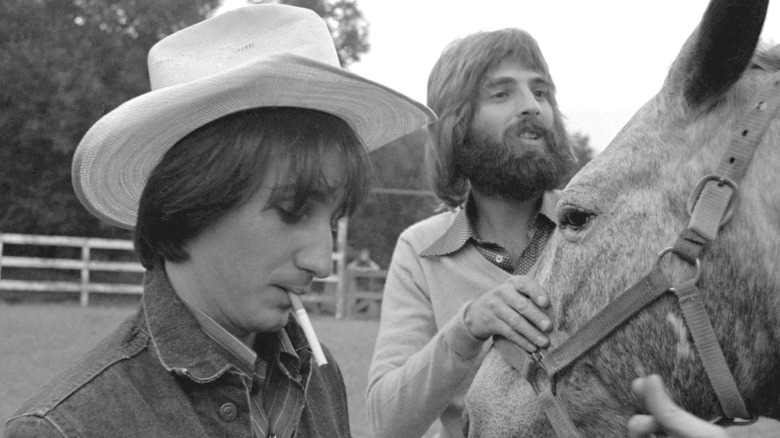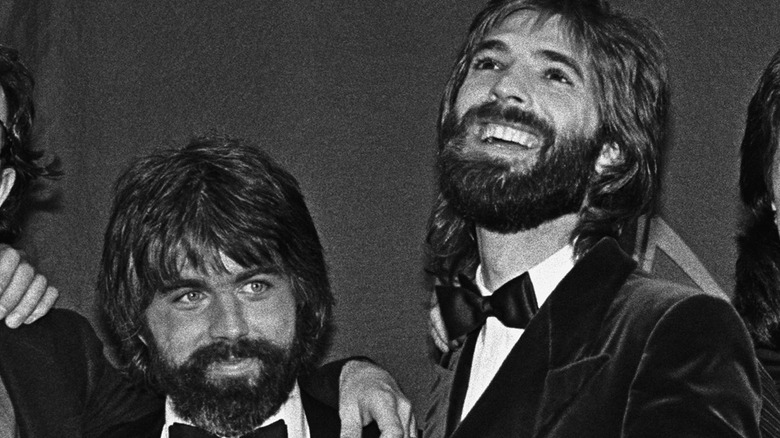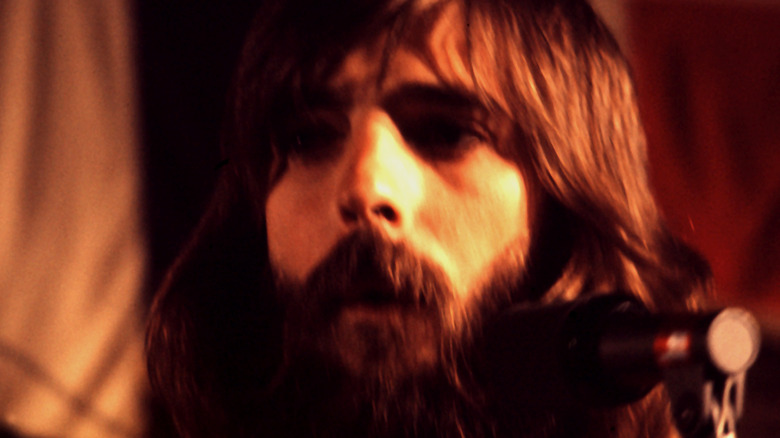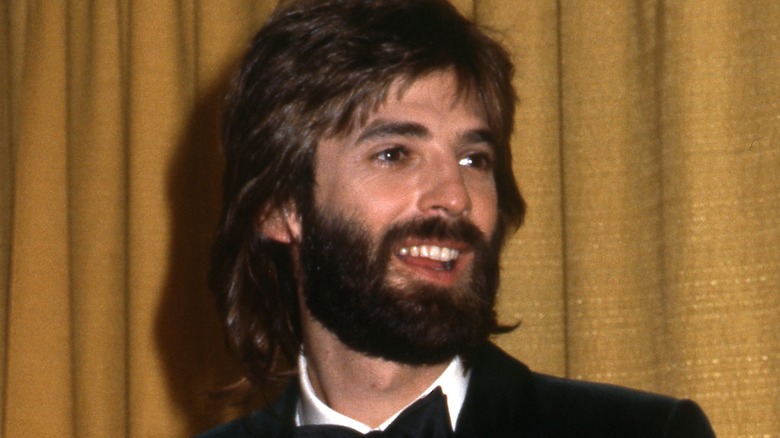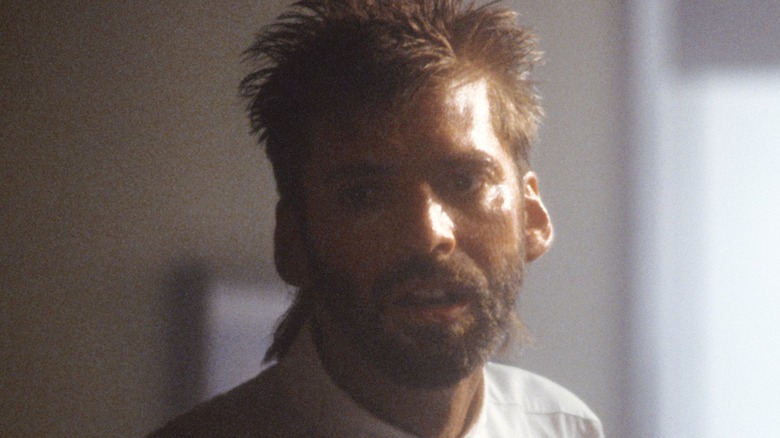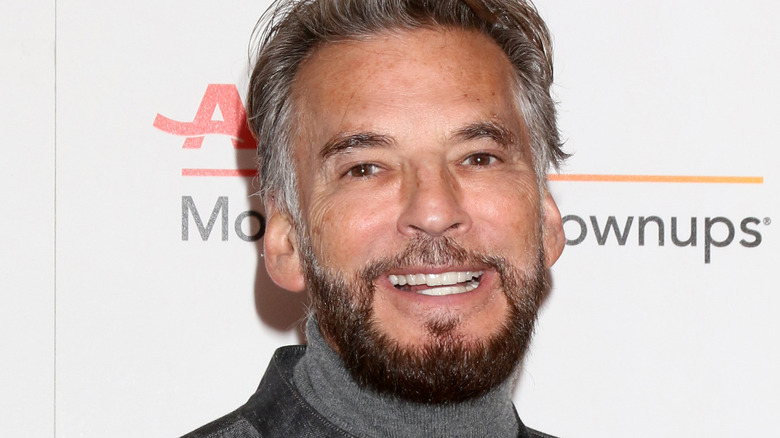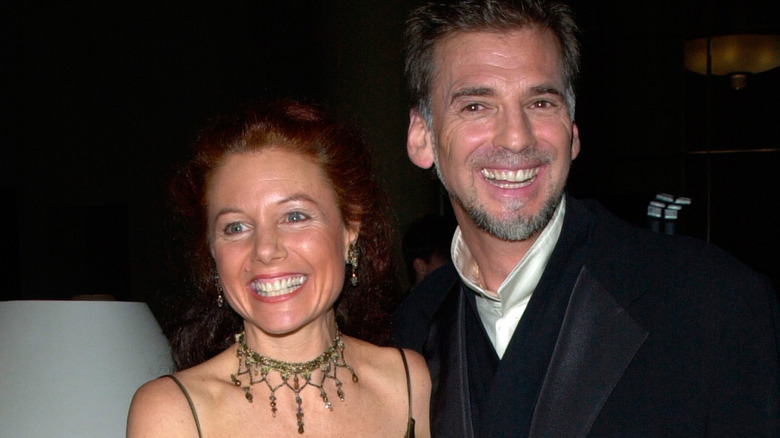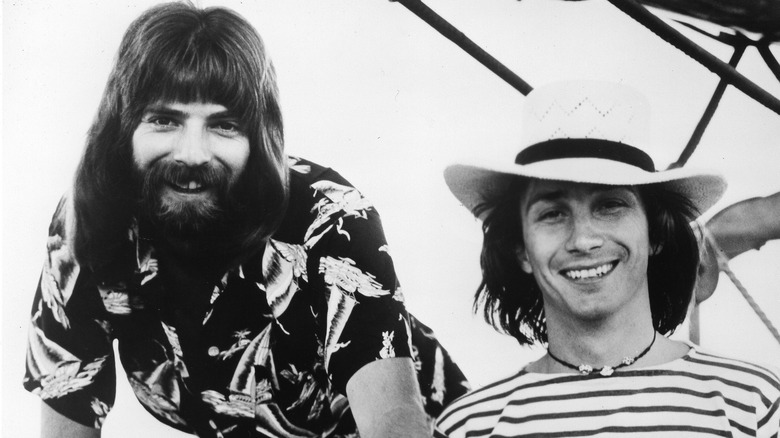The Untold Truth Of Kenny Loggins
He got just one life like everyone else, but musical journeyman and well-known superstar Kenny Loggins has lived a few different and very complete lives. He first emerged to the public in the very early 1970s as one-half of the good-time folk-rock duo Loggins and Messina. Then, after serving as a singer, songwriter, and architect of the late-1970s-defining "yacht rock" scene of smooth, pristinely-produced, sensitive and cool pop for grownups, he segued into a career as Hollywood's go-to movie soundtrack hitmaker, scoring hit songs with cinematically inspired work featured in "Caddyshack," "Top Gun," and "Footloose," among other major flicks of the time.
Through it all, Loggins has continued to write and record the kind of music he wants to make, all while navigating a rapidly changing industry and a productive, often tumultuous personal life. So heaven help the man (or anyone) who reads this piece about the pop and soft rock superstar, who after 50 years in the public is alright, don't worry about him. Kick off your dancing shoes, head for the danger zone, and read all about the life and career of Kenny Loggins.
Kenny Loggins broke into music quickly and successfully
Long before he'd find success as the member of a well-known duo and under his own name, Kenny Loggins began paying his dues not all that long after he discovered he had a love and aptitude for music in the first place. When he was 7 years old, as noted on his website bio, around 1955, the seed was planted and bloomed when he witnessed his older brothers try in vain to write a song. "I remember thinking, it just can't be that hard," he said. Within a year, and after a viewing of the movie musical "Yankee Doodle Dandy," about the life of composer and lyricist George M. Cohan, Loggins realized he also wanted to write music. "I knew deep inside that this is something I could do."
Growing up near Los Angeles, the center of the music industry in the mid-20th century, made it easy for Loggins to jump into the business right out of school, segueing from playing guitar in high school bands to working with the '60s psychedelic rock band the Electric Prunes to a guy in his early 20s hired by the ABC/Wingate recording company to be a staff songwriter for $100 a week. By 1970, 22-year-old Loggins had composed or co-composed four songs, including "House at Pooh Corner" for the Nitty Gritty Dirt Band's album "Uncle Charlie and His Dog Teddy."
Loggins and Messina were never supposed to be a duo
Loggins and Messina, consisting of Kenny Loggins and Jim Messina, scored a bunch of hits in the early 1970s, including "Your Mama Don't Dance," "Thinking of You," and "My Music." The two men's voices meshed well together, but they were not an organically formed duo that honed their skills and came up together as one unit. Messina, late of major rock bands of the era — Buffalo Springfield and Poco — was asked by Columbia Records to help write for and produce a Kenny Loggins solo album, scheduled to be recorded and released in 1971. They so enjoyed the partnership, and Messina contributed so much on-record music to the LP, that it was released under the name "Kenny Loggins with Jim Messina Sittin' In." It was a hit, and the duo would continue to record under the umbrella name Loggins and Messina.
But the arrangement couldn't last. "By the sixth year," Loggins told the Mercury News in 2009, "I was chafing at the bit, needing desperately to get out there. I was writing songs that were totally not Loggins and Messina." And so, the duo split up, with Loggins feeling that Messina resented him for giving up such a fruitful and profitable project. "In Jim's eyes, I was killing the golden goose."
Thank Stevie Nicks for Kenny Loggins
It's tough for a musician to break out of a group or band and go solo, with the record-buying public not necessarily willing to go along with the rocker or singer's new and unfamiliar directions. This uncertainty was certainly in the air when Loggins and Messina split up in 1976, as Kenny Loggins basically had to start all over again with his career, but without the benefits of his more seasoned and famous partner, Jim Messina.
Likewise, Loggins' burgeoning solo career got a big boost from another well-known and respected musician who voiced for him. According to Loggins' website bio, in 1977 he released his first all-alone record, "Celebrate Me Home," which earned the attention of Fleetwood Mac, who asked him to be an opening act on the tour in support of "Rumours," one of the best-selling and most popular LPs of all time. His proximity to Fleetwood Mac led to a friendship with one of that group's singer-songwriters, Stevie Nicks, who agreed to sing "Whenever I Call You Friend" as a duet with Loggins on his next album, 1978's "Nightwatch." While "Celebrate Me Home" peaked at a middling #27 on the Billboard album chart, "Nightwatch" peaked at #7, thanks in big part to "Whenever I Call You Friend," which became Loggins' first solo top five hit single.
Believe in Kenny Loggins
The biggest hit ever for the Doobie Brothers, an inductee in the Rock and Roll Hall of Fame: "What a Fool Believes," a #1 hit in 1979 that went on to win the Grammy Awards for Record of the Year and Song of the Year. A good chunk of credit for the tune goes to Kenny Loggins, never a member of the Doobie Brothers but a close associate of Michael McDonald, who made sure the song came together.
"The first verse was something I jotted down on an envelope, on a flight from New York back to L.A.," McDonald told Zane Lowe of Apple Music (via UCR). He then spent most of a year trying to work out the piano-led instrumentation, and was playing it at home one day, when Loggins came by and heard it, even though it wasn't ready. "And he goes, 'That's what I want to work on first,'" McDonald recalled. Loggins helped him flesh out "What a Fool Believes" that day, and got a co-writing credit. Loggins actually recorded it before the Doobie Brothers did, including a much different version on his 1978 album "Nightwatch."
A star wasn't born
In 1976, Barbra Streisand starred in a remake of "A Star is Born," playing an up-and-coming singer mentored by her lover, an aging alcoholic rock star played by Kris Kristofferson. The soundtrack is full of pieces written by major songwriters of the time, including Kenny Loggins, who penned the music for "I Believe in Love," performed in the film by Streisand. Loggins worked on the song in a brief career purgatory, between his Loggins and Messina split and before the release of his first solo album, according to the musician's website. According to The Northern Express, Loggins nearly had way more involvement with "A Star is Born," reportedly offered — and rejecting — the lead role in the film, which went to Kristofferson.
It may have not been in the cards for Loggins anyway, as he was still recovering from an accident. An avid wood carver, he so badly cut his hand around the time of the Loggins and Messina split that he couldn't play guitar for a while. "I actually cut my hand open wood carving — which is when I stopped wood carving," Loggins told the Dayton Daily News.
This Is It was it for Kenny Loggins
As Kenny Loggins helped Michael McDonald write "What a Fool Believes," McDonald helped Loggins complete the long journey to finishing "This Is It." "Michael McDonald and I must have written 'This Is It' four times," in the late 1970s, Loggins told American Songwriter. "The first three times it was a love song, 'Baby I this, baby I that,' and we both said, 'Eh! This is boring.'"
Meanwhile, Loggins' father was hospitalized for cardiovascular surgery, one of more than a dozen procedures he underwent after suffering several strokes and other health problems. As a result of the ordeal, the elder Loggins had given up hope, and according to his son, he had "made up his mind he was going to die on the operating table." During a hospital visit when his father spoke of his resignation to death, Loggins got upset. "This is it, Dad. Make a choice!" he recalled shouting at his parent. He left and went straight to a songwriting conference with McDonald, and was inspired by the words he'd said earlier that day. He realized the point of the song ultimately titled "This Is It": "It's not a love song. It's a life song." Loggins and McDonald were able to quickly finish the melody and write the rest of the lyrics, too. The song would hit #11 on the pop chart and bring Loggins a Grammy Award for Best Male Pop Vocal Performance.
How Kenny Loggins went from being Alright to Footloose
While co-penning a tune for "A Star is Born" was Kenny Loggins' first big foray into writing songs for major Hollywood movies, it would by no means be his last. Four years later, Loggins went to #7 on the pop chart with "I'm Alright," the groovy theme song from the anarchic golf comedy "Caddyshack." Loggins met Barbra Streisand's boyfriend, Jon Peters, while working on "A Star is Born," and Peters subsequently launched his own career as a producer with "Caddyshack." "He asked me if I wanted to check it out and write a song for it," Loggins told American Songwriter. He watched a rough cut without an ending and agreed to make a song.
In 1984, Loggins performed two songs on the soundtrack of the small town dancing drama "Footloose," the title song (a #1 hit) and "I'm Free (Heaven Helps the Man)." Lyricist Dean Pitchford, a sometime collaborator of Loggins, had asked for him to read the screenplay he'd written and, after performing that favor, Loggins performed two more, helping Pitchford write two songs, and quickly at that. "We wrote 'Footloose' in, basically, one night," Loggins told the Library of Congress. "I think for 'I'm Free' we took two nights."
It was a long way to the Danger Zone for Kenny Loggins
Nicknamed "King of the '80s soundtrack" by multiple media outlets, three Loggins signature songs all come from iconic '80s films — "I'm Alright" from "Caddyshack," "Footloose" from "Footloose," and "Danger Zone" from "Top Gun." Despite his massive success with the first two, which he at least co-wrote, Loggins didn't write "Danger Zone," nor was he an obvious or immediate pick to "Top Gun" producers.
According to Rediscover the '80s, composer Giorgio Moroder reworked some bits he'd written for the "Top Gun" score, collaborator Tom Whitlock wrote song lyrics, and they recorded a demo with a studio singer. "It took a while to figure out who was going to sing 'Danger Zone' because the record company that was going to release the soundtrack wanted an artist that was signed to their label," Whitlock said. Bryan Adams said no, and then so did Toto and REO Speedwagon. Eventually producers decided to go with Loggins, who'd already signed a deal to write another soundtrack cut called "Playing with the Boys," according to MovieWeb.
Going deep inside Kenny Loggins
In 1997, Kenny Loggins released an album titled "The Unimaginable Life" as well as a companion book with the same title, co-authored with his second wife and "healer" (per The Washington Post), Julia Loggins. The record includes a lot of deep and romantic poetry and lyrics expressing the couple's profound love for one another, while the print component (according to Orlando Weekly) goes into a lot of detail about Kenny Loggins' spiritual evolution, and how it came about via his devotion to colon hydrotherapy, or rather the extensive uses of invasive, pressurized water enemas to purify his person. (Before they were married, Julia Loggins was Kenny Loggins' hydrotherapist.)
"I used colonics to help bring emotional clarity and get in touch with me," the musician wrote in a book that includes detailed instructions and specifics on his entire enema process, which he says changed his entire essence for the better. "I had lost touch with my feelings, so I had to take the factor out of the way that might be blocking them."
Two divorces led to two Kenny Loggins albums
With his breakup of Loggins and Messina, Kenny Loggins is well known for one of the most famous duo splits in rock history. He's experienced a couple of tumultuous splits in his personal life, too. According to the Deseret News, his 12-year marriage to Eva Ein, with whom he had three children (and occasionally wrote music), ended in divorce in the early 1990s. Loggins dealt with the fallout publicly and artistically, recording the 1991 record "Leap of Faith," which is largely about the split, and the pain and damage it inflicted on himself and his family.
Loggins would love again, however. While processing the divorce and writing the songs that would make up "Leap of Faith," Loggins connected romantically with his colonic hydrotherapist, Julia, who he would later marry. Sadly for Loggins' heart, history would repeat. His second marriage also ended in divorce, in 2004, and Loggins dealt with it by recording the 2009 album "How About Now?" Songs included "I'm a Free Man Now" and "I Don't Want to Hate You Anymore," according to the Las Vegas Sun. "It's been five years and I'm still reeling," Loggins said. "I got pretty blindsided by Julia's decision to leave. She's a very impulsive woman, and she found herself going through a midlife crisis."
Kenny Loggins' son is a musician, too
Altogether, and over the course of two marriages, Kenny Loggins became a father five times over, with wife Eva Ein giving birth to Crosby, Cody, and Isabella, and second spouse Julia welcoming Lukas and Hana in the 1990s. Loggins' eldest, Crosby, born in 1980, has followed his father into the family business of professional music-making. Trading in the singer-songwriter vernacular, the younger Crosby led several bands, according to AllMusic, such as Crosby Loggins and the Leadbirds, Crosby Loggins and the Namedroppers, and Crosby Loggins and the Light, with whom the musician recorded his first album, 2007's "We All Go Home," which includes 10 self-composed tunes.
Loggins released a second collection, "Time to Move" on major label Jive Records in 2009, not long after he won a reality TV show competition. After turning down offers to appear on MTV's "Rock the Cradle" three times, Loggins relented and competed on the "American Idol"-type singing show for the offspring of celebrity musicians. Loggins' championship concluded with a performance of "I'm Alright," sung alongside the originator of that tune, his father.
Loggins and Messina weren't friends back then but they are now
The names "Loggins" and "Messina" will probably forever be inextricably linked together. The duo broke up in 1976 so that Kenny Loggins could pursue his musical muse. To his chagrin, Jim Messina, per the Mercury News, didn't enjoy a solo career on par with that of his former musical partner, in terms of cultural clout or charting hits. Any lingering resentment notwithstanding, the end of Loggins and Messina didn't spell the end of a friendship, because there wasn't one there to begin with — not really, at least. "We were never close buddies that hung out a lot because we're different kinds of people," Loggins told the Detroit Free Press (via the Baltimore Sun).
That doesn't mean that Loggins and Messina hate each other. They can at least put aside their differences when one needs the other. In 2005, Messina played on a few songs at a Loggins show, and Loggins played a few songs at a Messina show, all orchestrated by the former Poco musician to help his old bandmate through a tough divorce. "He turned to me and said, 'Buddy, I know what you need right now," Loggins recalled. "'You need to go out on the road."' That spawned a Loggins and Messina reunion tour and the recording of a new song, "Two of Us." Rock Cellar Magazine reports that the two will reunite once more for some dates in the summer of 2022.


